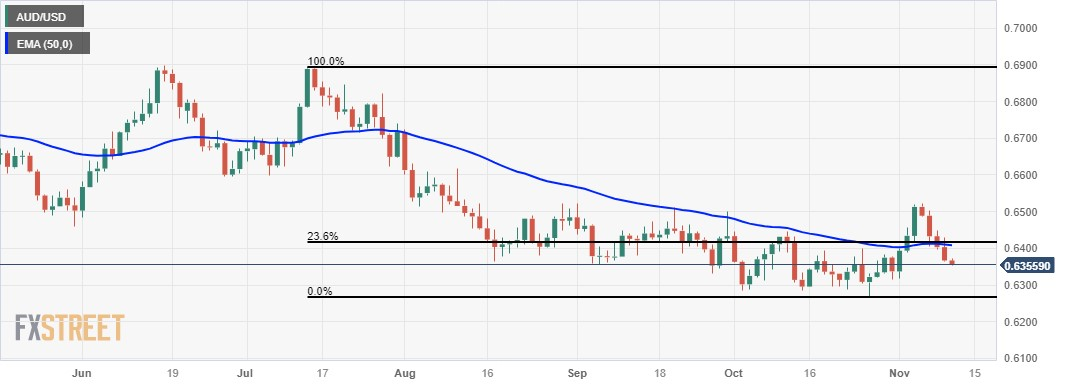- Australian Dollar continues to move on a downward trajectory.
- Australia’s central bank stated that inflation is more persistent.
- Fed Chair Powell expressed concern that the policy measures in place may not be restrictive enough.
The Australian Dollar (AUD) embraces its losing streak that commenced on Monday. The AUD/USD pair faces downward pressure following the hawkish remarks made by US Federal Reserve (Fed) Chair Jerome Powell on Thursday. Powell's comments triggered an upward surge in the US Dollar (USD) and US Treasury yields, impacting the pair.
Australia's central bank issued its Monetary Policy Statement (MPS) on Friday, indicating that inflation in the country has likely surpassed its peak. However, the statement notes that inflation continues to be elevated and is proving to be more persistent than initially expected a few months ago. The board's main focus is to bring inflation back to its target. After deliberation, they contemplated a pause in November but ultimately decided that a rate hike would offer greater assurance in addressing inflation concerns.
The Reserve Bank of Australia (RBA) struck a dovish tone at their last meeting despite delivering a 25 basis point rate hike. RBA adopts a data-dependent strategy in response to persistent challenges from inflation and a slowing Australian economy.
Fed Chair Powell is concerned they might not have implemented a sufficiently restrictive policy to bring inflation down to the 2% target over time. However, there is a widespread belief in the markets that the Fed has concluded its tightening cycle.
Moreover, on Thursday, the US weekly Initial Jobless Claims for the week ending November 4 turned out to be lower than what the market had anticipated. This outcome can potentially strengthen the belief in a robust labor market in the United States (US), offering additional support for the Greenback.
Daily Digest Market Movers: Australian Dollar continues to move on a downward trajectory for the fifth successive day
- RBA raised the Official Cash Rate (OCR) from 4.10% to a 12-year high of 4.35%, responding to the latest Monthly Consumer Price Index (YoY) for September, indicating a notable increase of 5.6%, surpassing the expected 5.4% growth.
- Australia’s TD Securities Inflation (YoY) fell to 5.1% in September from 5.7% prior.
- Australia’s Retail Sales grew 0.2% in the third quarter after contracting by 0.6% in the previous quarter.
- Economists at the National Australia Bank (NAB) anticipate another 25 basis points hike in February following the Q4 inflation data. Additionally, NAB believes that rate cuts are unlikely to commence until November 2024.
- China's Consumer Price Index (CPI) witnessed an annual decline of 0.2% in October, compared to the expected 0.1% decrease. The monthly CPI dropped by 0.1%, contrasting with the earlier 0.2% growth.
- Pan Gongsheng, the Governor of the People's Bank of China (PBOC), expressed optimism on Wednesday, saying that China's economy is on a positive trajectory and is anticipated to achieve the 5% growth target successfully.
- Additionally, the International Monetary Fund (IMF) has adjusted its outlook for China's Gross Domestic Product (GDP) growth, now projecting a 5.4% growth rate in 2023, up from the initial forecast of 5.0%, and 4.6% in 2024, surpassing the previous estimate of 4.2%.
- Fed Governor Michelle Bowman reinforced the opinion that the US Fed is contemplating future increases in short-term interest rates. Moreover, Neil Kashkari, President of the Minnesota Fed, questioned whether the central bank had raised rates sufficiently. Kashkari cited the economy's resilience as a factor influencing his perspective.
- US weekly Initial Jobless Claims for the week ending November 4 totaled 217K, slightly below the market forecast of 218K and the previous week's figure of 220K.
- The US Bureau of Labor Statistics recently unveiled the Nonfarm Payrolls (NFP) data for October, disclosing a figure of a 150K increase in jobs. This missed the expected 180K and marked a substantial drop from September's 297K.
Technical Analysis: Australian Dollar drops to 0.6350, aiming for the previous week's low
The Australian Dollar hovers around the crucial support level of 0.6350 on Friday. If there's a clear break below this level, it may lead the AUD/USD pair on a downward trajectory, aiming for the previous week's low at 0.6314. On the upside, the initial resistance is marked by the 50-day Exponential Moving Average (EMA) at 0.6408, closely followed by the 23.6% Fibonacciretracement at 0.6415, and then the psychological barrier at 0.6500.
AUD/USD: Daily Chart

Australian Dollar price this week
The table below shows the percentage change of Australian Dollar (AUD) against listed major currencies this week. Australian Dollar was the weakest against the US Dollar.
| USD | EUR | GBP | CAD | AUD | JPY | NZD | CHF |
| USD |
| 0.56% | 1.22% | 1.07% | 2.35% | 1.18% | 1.67% | 0.46% |
| EUR | -0.57% |
| 0.66% | 0.51% | 1.81% | 0.62% | 1.11% | -0.11% |
| GBP | -1.23% | -0.67% |
| -0.16% | 1.13% | -0.05% | 0.45% | -0.78% |
| CAD | -1.08% | -0.51% | 0.15% |
| 1.32% | 0.11% | 0.60% | -0.62% |
| AUD | -2.43% | -1.85% | -1.18% | -1.34% |
| -1.22% | -0.72% | -1.96% |
| JPY | -1.20% | -0.62% | -0.18% | -0.09% | 1.18% |
| 0.47% | -0.73% |
| NZD | -1.70% | -1.12% | -0.45% | -0.60% | 0.72% | -0.49% |
| -1.21% |
| CHF | -0.46% | 0.10% | 0.76% | 0.60% | 1.89% | 0.72% | 1.20% |
|